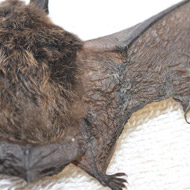
US Fish and Wildlife Service ‘extremely concerned’
A devastating fungal disease of bats, which can lead to disturbed hibernation, dehydration and death, has reached the west coast of America, prompting concerns from the US Fish and Wildlife Service.
White Nose Syndrome (WNS) was first seen in North America in the winter of 2006/2007. Since then, the disease has spread to 28 states and five Canadian provinces, wiping out over six million bats in its path.
Now the disease has been confirmed in a little brown bat (Myotis lucifugus), found by hikers while out walking in Washington State.
Noticing the bat looked unwell, the hikers handed the creature to a local animal welfare centre. The bat died two days later and had visible symptoms of a skin infection common in bats with WNS.
The bat was subsequently passed to the US Geological Survey’s (USGS) National Wildlife Health centre for testing, where it was confirmed that the bat did indeed have the disease.
News of the discovery has prompted concern from the U.S Fish and Wildlife Service as Washington State has 15 species of bats which benefit humans by consuming large quantities of insects.
“We are extremely concerned about the confirmation of WNS in Washington state, about 1,300 miles from the previous westernmost detection of fungus that causes the disease,” said U.S Fish and Wildlife Service Director Dan Ashe.
“Bats are a crucial part of our ecology and provide essential pest control for our farmers, foresters and city residents, so it is important that we stay focused on stopping the spread of this fungus.”
Suzette Kimball, director of the USGS, adds: “This finding in a far-western location is unfortunately indicative of the challenges we face with the unpredictability of WNS.
"This underscores the critical importance of our work to develop tools for early detection and rapid response to potentially devastating wildlife diseases."
WNS is named for the fuzzy white fungal growth that is often found on the muzzles of infected bats.
The fungus invade hibernating bats’ skin and causes damage, especially to delicate wing tissue. It can also cause physiologic imbalances that may lead to disturbed hibernation, depleted fat reserves, dehydration and death.
The US Fish and Wildlife Service, who lead the national WNS response effort, say that the first step will be to conduct surveillance near where the bat was found 'to determine the extent of WNS in the area'.
The response will be coordinated by the Washington Department of Fish and Wildlife (WDFW) who are responsible for bat management and conservation in Washington State.
WDFW veterinary surgeon Katie Hamn said the disease is transmitted primarily from bat to bat. However people can carry fungal spores on their clothing, shoes or carving gear.
She said that it most likely had been roused from hibernation and was attempting to feed at a time of very low insect availability.
“At this point we don’t know where the infected bat may have spent the winter, but it seems likely that it was somewhere in the central Cascades,” she said.
Image (C) Progressive Animal Welfare Society, Lynnwood WA (USA).



 The RCVS has announced a new version of its 1CPD mobile app, with enhanced features for veterinary surgeons and veterinary nurses to record their continuing professional development.
The RCVS has announced a new version of its 1CPD mobile app, with enhanced features for veterinary surgeons and veterinary nurses to record their continuing professional development.